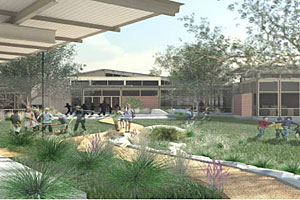Karen Duckett, AIA, has attended pre-proposal meetings for public projects such as libraries and schools for years, usually encountering representatives of the same 15 or 20 Atlanta-area firms. Not anymore. At a recent meeting, 90 firms showed up, most seeking work to make up for the dearth of private sector projects. “The private sector is way, way down. Those firms that do development—residential, multifamily, commercial—they’re really hurting,” says Duckett, president of Atlanta-based, 20-person Duckett Design Group.

Architects from Miami to San Antonio confirm Duckett’s report: firms in the southern U.S. are seeing a major downturn in private-sector projects and increased competition for public-sector and institutional work.
“The private sector has more or less dried up,” says Bernard Zyscovich, AIA, president of Miami-based Zyscovich Architects, a 100-person firm with offices in New York and Orlando. Firms have been forced to lay off employees, with Zyscovich seeing many companies in southern Florida cutting 20 to 80 percent of their staff. Marlon Blackwell, FAIA, of Fayettville, Arkansas-based Marlon Blackwell Architects, recently had to let go employees at his private-sector-based practice; he calls the process “heartbreaking.”
Opportunities still exist in the public sector, along with healthcare and education, say observers. Relying on its mix of urban design, planning, education, and aviation, Zyscovich Architects has seen its billings drop only about 15 percent. “Our firm is well-situated because of the large diversity of services we provide,” Zyscovich says.
Meanwhile, architects previously focused on private development are hungry to get a bite of the public-sector pie, but diversifying a practice in the middle of a recession poses a huge challenge. “The vast majority of architects do not have public experience,” says Zyscovich. “They’re not familiar with the processes and they’ve not developed the relationships. And it’s difficult to break into new markets in the best of circumstances.”
Marlon Blackwell sees the same process from the other side, as he shifts his five-person firm’s attention to schools and libraries. “We’ve never had to go out and look for work before,” he says. “So we’ve revamped our RFQ process, and we’re remaking our Web site. We’re trying to be selective still, but we’re getting in front of people.” He adds that he’s had success partnering with firms with strong public portfolios.
While the entire South is suffering, with the region as a whole reporting a score of 35.5 on the AIA’s Architectural Billings Index in February, a 17-point drop from February 2007, the effect appears greatest near the Eastern Seaboard. Firms closer to the center of the country describe a less drastic downturn. (The Gulf Coast around New Orleans, still recovering from hurricane damage, is the exception.)
Kentucky, for example, is weathering the storm, according to Bob Hafferman, AIA, principal with K. Norman Berry Architects, based in Louisville, Kentucky. “We’re a more stable market than others,” says Hafferman, whose 16-person firm focuses on schools, offices, and commercial buildings. “Our ups are not very high, but our lows are not very low.”
In fact, some areas seem to be bouncing back. “I think the big picture is looking at lot better,” says Greg Papay, FAIA, partner with San Antonio-based Lake-Flato Architects, a 60-person firm with work in the residential, cultural, commercial, and education sectors. “We’re still nervous, still a little on edge, but we feel cautiously optimistic,” he says. A few residential projects have even come their way—not the backlog the firm had in previous years, but an improvement.
Meanwhile, architects across the South are evaluating their options. “We’re doing things a little smarter. We’re asking, How do we restrategize? How do we present ourselves?” says Blackwell. “I’m hopeful—I try to be really hopeful.”
Read more economic news in our Recession and Recovery special section.





Post a comment to this article
Report Abusive Comment